Updated on January 25, 2017
New Year’s in Vero Beach and then on to Palm Beach
December 29, 2016 to January 14, 2017
Latitude North 26 Degrees 42 Minutes
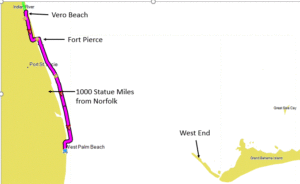
The weather did not cooperate for a December 29th sailing, so we decided to spend New Year’s in Vero Beach. We celebrated New Year’s Eve with John having a traditional Russian New Year’s dinner and dancing on the bow to the music of a nearby party ashore. The next day I spent my birthday riding public buses and walking trying to find parts at Home Depot, not exactly what I had in mind for a celebration.
We finally decided to depart on January 5th. We refueled and topped off the water tanks at 8am, took our final goodbyes to John and motored 10 miles to Fort Pierce and the inlet to the Atlantic Ocean.
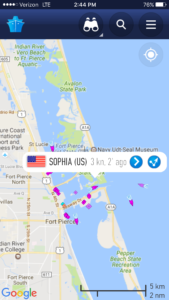
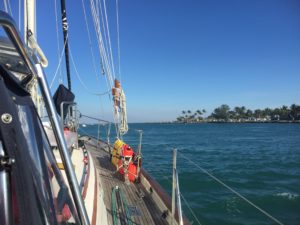
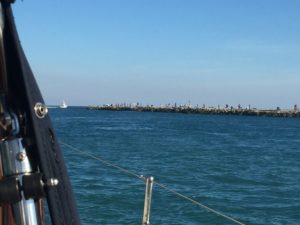
We were in the Atlantic by noon and had an uneventful nighttime sail to Lake Worth Inlet at Palm Beach. One milestone that was attained: We passed the 1000 statue miles marker on the Intracoastal Waterway. This is 1000 miles of ICW from Norfolk VA. (of course we were in the Atlantic at the time, but it was still a milestone for us.)
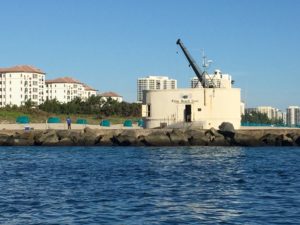
The anchorage recommended by some experienced cruisers was centrally located near the city docks, but was crowded and difficult. It is relatively narrow east-west, between the shallows of Palm Beach island and the ICW channel where there is heavy traffic, often with large super-yachts. There is a north-south 3 knot current and we were expecting 30 knot north winds. This shows our track while trying to find an anchorage.

side, but as boats began to pass, I thought we were uncomfortably close to the channel. We were advised that there was water deep enough on the east side of everyone (toward the Atlantic side) and we anchored there, next to a sailboat of substantial size. The owner of the sailboat claimed he had 100 feet of chain out, and we tried to make sure we were outside of his swing circle. (Radius of Swing circle = length of chain plus length of boat). All was alright for several tide changes. On Saturday, January 7, the cold front came through and we got the forecasted 30 knot winds. We came closer and closer to the boat until it was uncomfortable. I started to shorten my chain without waking up Elena, but this carried the risk of pulling the anchor out of its holding, which exactly what happened. I called Elena to start the engine, which she did quite efficiently. We got so close to the other boat that we pushed off each other.
At this point, we needed to re-anchor, but all was in control. For some reason, the other guy decided he need to wake up everyone in the anchorage. He took out his air horn and kept blowing it until he woke everyone else up. I suspected he did this just to embarrass me. I never got his name but his locations on the charts are labeled “Jerk” (we had other names, but decided not to put them in print.) Later, that evening another boat, “Tiki Trek”, “bumped” him. Tiki Trek is a full keel boat like Sophia and was swinging much differently from the “Jerk” who is a much bigger boat with a smaller “fin” keel. By my calculations “Jerk” had a swing circle diameter of over 300 feet, eating up a lot of real estate in a small anchorage. Later, when someone would come in looking for an anchorage, he would angrily shoo them away. Twice, we got on the radio and helped fellow cruisers who were “shooed“ away find an anchorage. Since I was on a Bahamian moor, swing was minimized and they could comfortably anchor near us.
Lessons learned in this exercise was the effect of current. While wind will affect boats very similarly, currents affect boats in all sorts of manners. And when slack current happens (zero current between high and low tides which happens twice a day), the winds take over. It is all a complex calculus in a tight anchorage.
It was about 2am now and there was no traffic in the channel and given that Sunday would be cold and windy, not likely to be much. We anchored near the channel for the night. On Sunday, we re-anchored again trying to get out of the channel without crowding anyone. On Monday, the boat next to us (we called him the Belgian, because we did not recognize the tricolor flag) moved and left a space.
We pulled the anchor again and slid over. We then decided to do something that we had never done, the Bahamian moor. Essentially, it is putting a second anchor directly downstream of a current from the primary anchor, minimizing the radius swing circle theoretically to the length of the boat. After getting the primary anchor out, we put the dinghy in the water, lowered the secondary with its 30 feet of chain into the dinghy, motored out 100 feet, and lowered the secondary anchor and hauled in on the anchor line from Sophia,. The anchor held. When we finished, the GPS which is in the cockpit and near the stern of boat reported positions within 100 feet (Sophia is 40 feet long). This was a good exercise because we expect to use the two-anchor moor frequently in the Bahamas where there are frequently strong tidal currents. In addition, the tactic of putting out an anchor when running aground to “kedge” off the shoal is a great tool to have in case of grounding.
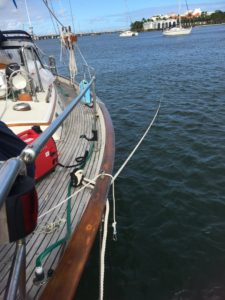
So we anchored and re-anchored 5 times in three days, not counting the times that the anchor did not hold or we were not happy and we had to try again (I know this happened at least 3 times, but maybe more). Keep in mind that we have a manual anchor windlass and each time we bring in the anchor takes at least 15 minutes of cranking back and forth on the windlass to bring in 100 feet of chain.
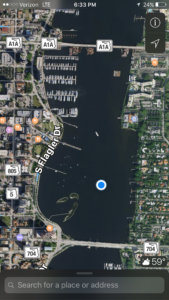
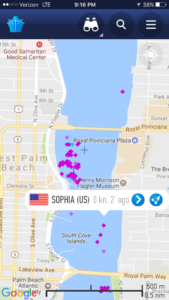
A small note. During the first anchoring, after setting the anchor, I looked up and there on the west side of the channel, was a tall office building whose name at the top was “Trump Plaza”. Not exactly what I wanted to be reminded of during out stay here.
Our impressions of Palm Beach are not all that good. This is a place which follows the “golden rule”, as in “He who has the gold makes the rules.” The marinas are filled with mega-yachts and do not welcome cruisers. The rates at the marinas are twice what we have seen elsewhere (we would have to pay $150 dollars a night). A crowded anchorage and no mooring balls. We cannot even fill our five gallon water tanks to replenish our water supply at the marina. We are using the fire hydrants on the city dock using a funnel to capture the water as it flows. There is no laundry to use and few stores nearby. The Post Office would not accept general delivery so we had difficulty having our mail forwarded. West Marine is 8 miles away. We have been using Uber successfully to get around, but that is adding to our expenses.
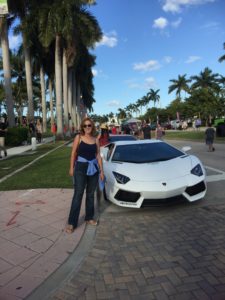
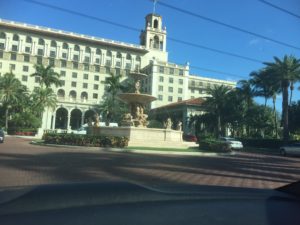
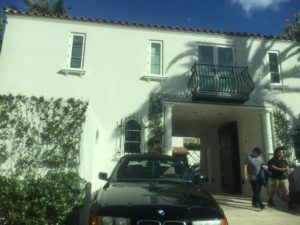
We probably won’t be back. The next inlet is Fort Lauderdale, but its reputed to be even worse, with no anchorages near the inlet. While Miami also has a bad reputation, at least there is Bay Biscayne to anchor in. The next trip south we will stay offshore from Ft Pierce to Miami (two-day sail) and then sail northeast on the Easterly winds and with the current of the Gulf Stream.
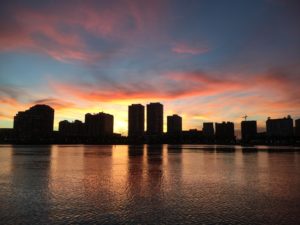
We have been waiting for the weather to change. Without a weather system (a cold front or a high pressure ridge), the trade winds predominate. The trades are directly out of the east and we have experienced those winds for the last week and still have a few more days of east winds forecasted. I did not want to attempt a first crossing with Elena with a stiff head wind. On Wednesday, the winds are expected to veer to the south and we expect to sail across the Gulf Stream and onto the Abacos Islands of the Bahamas. We are now as far south as we are going for a while. Our next stop is due west and then we turn northwest to cruise the northern islands in the Bahamas, We will start south again in February if all is well heading for the more southerly islands.

Hello Cecil & Elena, Enjoy reading your blog. I’ve heard anchoring in Florida is a challenge. Wish you fair weather on the crossing.
Thanks Bubby and Elena for your expert accounting and beautiful pictures. How delightfully challengin! I 阿门in Guangzhou, China in a quiet time of day to catch up on your travels.
New word OF THE DAY….. RADIUS OF SWING ….
tHE HOTEL COMPUTER KEEPS CHANGING INTO CHINESE CHARACTERS … LOL
Love to you,
Martha
PS your Sophia might be considered a toy of the rich , its all relative , enjoy
Time for the next log. Lovin it!